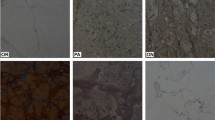Abstract
Carbonate rocks have been extensively used as building stones because of their availability, workability, and attractiveness. Unfortunately, however, some stones suffer from chemical attack or freeze-thaw activity. The environmental affects, especially those due to pollution of the atmosphere, are discussed in terms of weathering processes, salt crystallization, and acid deposition. A review of some recent research in relation to deterioration of stone in urban environments is given and carbonate rocks are classified in relation to position within a building, geographical location, and degree of pollution. Some comments on stone preservation are provided, especially in terms of the properties a preservative should possess.
Similar content being viewed by others
References
Anon. (1975) Decay and conservation of stone masonry. Digest 177. Watford: Building Research Establishment, Her Majestry's Stationary Office
Anon. (1977) The description of rock masses for engineering purposes. Q J Eng Geol 10:355–388
Anon. (1979) Classification of rocks and soils for engineering geological mapping. Part 1-Rock and soil materials. Bull Int Assoc Eng Geol 19:364–371
Anon. (1983) The selection of natural building stone. Digest 260. Watford: Building Research Establishment, Her Majesty's Stationary Office
Anon. 1984. Airborne sulphur pollution—effects and control, report prepared within the framework of the convention on long range transboundary air pollution. New York: United Nations Economic Commission for Europe, United Nations
Anon. (1985a) The effects of air pollution on historic buildings and monuments. Padua: Commission of the European Communities
Anon. (1985b) Atmospheric measurement of air: Pilot study on conservation and restoration of monuments. Bonn: North Atlantic Treaty Organization
Arnold A (1981) Nature and reactions of saline minerals in walls. Proceedings, Conference on The Conservation of Stone II, Bologna. pp 13–23
Arnold A (1982) Rising damp and saline minerals. Proceedings fourth international congress on the deterioration and preservation of stone. Louisville. pp 11–28
Bell FG (1981) A survey of the physical properties of some carbonate rocks. Bull Int Assoc Eng Geol 24:105–110
Bell FG (1990) Preservation and restoration of historic buildings: Two case histories. Proceedings, international conference on techniques of restoration and methods of evaluation of safety, Bangkok. Rotterdam: AA Balkema. pp 54–64
Bell FG, Coulthard JM (1988) Stone preservation with illustrative examples from the United Kingdom. In: Marinos PG, Koukis GC (Ed), Proceedings, international conference on engineering geology of ancient works, monuments and historical sites, Athens, vol 2. Rotterdam: AA Balkema. pp 883–889
Building Effects Review Group (1989) The effects of acid rain deposition on buildings and building materials in the United Kingdom. London: Her Majesty's Stationary Office
Butlin RN (1988a) A study of the deterioration of Lincoln Cathedral. Proceedings, sixth international congress on the deterioration and conservation of stone, Turin
Butlin RN (1988b) Acid deposition and stone. Struct Surv 7(3): 1–6 (offprint)
Butlin RN, Cooke RU, Jaynes SM, Sharp AD (1985) Research on limstone decay in the United Kingdom. Proceedings, fifth international congress on deterioration and conservation of stone, Lausanne. pp 536–546
Camuffo D, Del Monte M, Sabbion C, Vittori O (1982) Wetting deterioration and visual features of stone surfaces in an urban area. Atmos Environ 16(9):2253–2259
Clarke BL, Ashurst J (1972) Stone preservation experiments. Watford: Building Research Establishments, Her Majesty's Stationary Office
Garrels RM, Thompson ME, Siever R (1960) Stability of some carbonates at 25‡C and one atmosphere total pressure. Am J Sci 258:402–418
Hart D (1988) The building Magnesian Limestones of the British Isles. Watford: Building Research Establishment, Her Majesty's Stationary Office
Haynie FH (1983) Deterioration of marble. Durability Build Mater 1(3):241–254
Honeyborne DS (1982) The building limstones of France. Watford: Building Research Establishment, Her Majesty's Stationary Office
Hudec PP (1978) Rock weathering on the molecular level. In: Winkler EM (Ed), Decay and preservation of stone, engineering geology case histories No. 11. New York: Geological Society of America. pp 45–51
Jaynes SM, Cooke RU (1987) Stone weathering is south east England. Atmos Environ 21(7):1601–1622
Larsen TD, Cady PD (1969) Identification of frost susceptible particles in concrete aggregates. National Cooperative Research Program, Report 66. Washington, D.C.: Highway Research Board
Lockat S (1977) Stone deterioration at Cologne Cathedral and other monuments due to action of air pollutants. Proceedings, fourth international clean air conference, Tokyo. pp 120–128
Mamillan M (1976) Nouwelles connaissances pour l'utilisation et la protection des pierres de construction. Ann Inst Tech Batim Trav Publics, Ser Mater 48 (Suppl 335): 18–48
Price CA (1981) Brethane stone preservatives. Current paper CP1/81. Watford: Building Research Establishment, Her Majesty's Stationary Office
Price CA, Ross KD (1984) The cleaning and treatment of limestone by the lime method. Part II: A technical appraisal of stone conservation techniques employed at Wells Cathedral. Monumentum 27:301–312
Reddy MM (1988) Acid rain damage to carbonate stone: A quantitative assessment based on aqueous geochemistry of rainfall run-off from stone. Earth Surf Processes Landforms 13:335–354
Reddy MM, Werner M (1985) Composition of rainfall run-off from limestone and marble at Research Triangle Park, North Carolina. United States Geological Survey Open-File Report 85-630. pp 1–6
Weyl PK (1958) The solution kinetics of calcite. J Geol 66:163–176
Winkler EM (1973) Stone properties: Durability in man's environment, New York: Springer-Verlag
Winkler EM (1978) Stone decay in urban atmospheres. In: Winkler EM (Ed), Decay and preservation of stone, Engineering geology case histories No. 11. New York: Geological Society of America. pp 53–58
Winkler EM (1987) Weathering and weathering rates of natural stone. Environ Geol Water Sci 9(1):85–92
Yates TJS, Coote AT, Butler RN (1988) The effect of acid deposition on buildings and building materials. Constr Build Mater 2(1): 1–7 (offprint)
Author information
Authors and Affiliations
Rights and permissions
About this article
Cite this article
Bell, F.G. Durability of carbonate rock as building stone with comments on its preservation. Geo 21, 187–200 (1993). https://doi.org/10.1007/BF00775905
Received:
Revised:
Issue Date:
DOI: https://doi.org/10.1007/BF00775905



